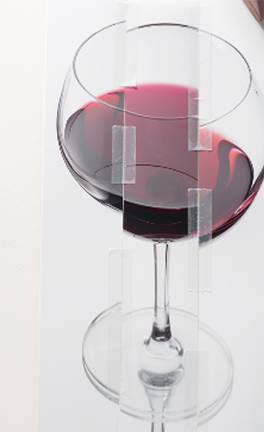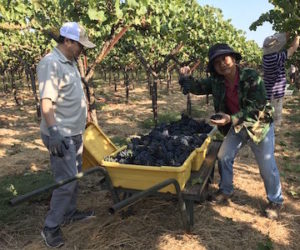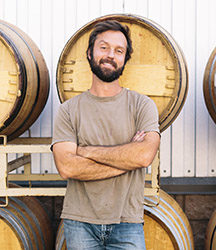 The moment of truth in winemaking often comes when you taste your wine to see how it turned out and you wish it could be just a touch better. Maybe the wine is filled with ripe fruit flavors but is not rounded by a touch of vanilla, a hint of chocolate, or the suppleness of plum. You wonder how you could achieve those flavors but you don’t have a clue.
The moment of truth in winemaking often comes when you taste your wine to see how it turned out and you wish it could be just a touch better. Maybe the wine is filled with ripe fruit flavors but is not rounded by a touch of vanilla, a hint of chocolate, or the suppleness of plum. You wonder how you could achieve those flavors but you don’t have a clue.
The answer is blending. Professional winemakers are the first to admit that few stand-alone wines have all the characteristics of a perfect finished wine. Blending lets them pick the finest characteristics of two, three, or even more wines, and marry them together for that award-winning flavor. This is a centuries-old technique that should and can be practiced by the most novice of home winemakers.
As our pros indicate, there is no trick to the process. Instead, it’s all about running tests, comparing flavors, and finding the perfect ratio before you commit to the final blend. Your ultimate goal is to create something that suits your personal tastes while creating the best final product in the end. Here are some tips on reaching that goal.
David Noyes: Kunde Winery in Kenwood, California. Earned a degree in Fermentation Science at U.C. Davis and worked in France before Kunde opened in 1990.
If you have a small amount of bad wine, it’s not a good idea to blend it with a larger amount of good wine. Instead of improving the quality of that bad wine, the blend will actually fall to the lesser quality.
The goal in blending is to bring together wines that don’t stand alone to make a wine that is superior to its parts. There is a big difference between blending, which is meant to improve your wine, and mixing, which is intended to make something — like an off-flavor —go away.
Always blend on a trial basis. Using a graduated cylinder, mix X milliliters of one wine with Y milliliters of another wine. Then taste it and make minor adjustments to other tests until you find the blend you like.
Often, if you put young red wines together, they might taste awkward or rough at first, but if you let them sit for a while the components will marry and you’ll get a good sense of how the final wine will taste. With whites you can usually blend and know right away what the final wine is going to be like.
In general I think that the sooner after fermentation that you blend wines, the better it is for the final product. This protects against oxidation, since you aren’t racking the wines around and you get them sealed in an aging vessel. But it also allows the wines to grow together and become a single wine. Of course, if you’re unfamiliar with your grapes, it might be better to wait until you have a better idea of the individual tastes. Blending early after fermentation assumes you have a sense of how those individual batches will mature.
There are several keys to blending. First, recognize that most wines benefit from blending. It’s important to find a balance between the different components that you are blending together. Also, you’re shooting to get the flavors you prefer in the finished wine. If you’re fortunate, you’ll get small components of flavor that really accentuate the characteristics of the final wine.
Remember when blending that a little anchovy is great for the sauce, but you don’t want to overwhelm it with fishy flavor. Use common sense and strive for balance.
Jerry Sass: Wild Winds Winery (Sass Winery) in Salem, Oregon. Jerry was an amateur winemaker for many years before he started working professionally during the harvest.
I used to blend flavor and aromas that I liked and then see what happened. Now that I know my winery better and have a better sense of what the grapes will produce, I can focus more on the accents that help create a better wine.
I keep all of my wines separate prior to blending. I separate different wines during fermentation and then do separate blending trials before I make a final decision. When it comes time to do my blending tests, I can have thirty different wines going. This allows me to do lots of mixing and testing before finding the best combination.
Doing blending trials is a great way to make that perfect wine. Whether you have an idea of what you’re trying to accomplish or not, you can just run a bunch of tests until you find something you like.
Since you’re just trying to see what happens with the flavor when you blend, the trials are done in small amounts. When I do a tasting, I’ll usually taste it right away and then let the wine sit for a couple days before tasting again. This lets me see if my mind is changing or if the peanut butter I had for lunch that first day affected my taste buds.
The blending process will be different for different styles. For a Pinot Gris, blending is simple. The wine has nice pear and citrus flavors, or apple or vanilla components, but it isn’t too complex.
Winemakers need to find these flavors and create a balanced blend. A Chardonnay is more complicated since there are so many different flavors and aromas. Isolate the flavors you like, then blend together small trial batches until you find the preferred ratio. The same holds true for Pinot Noir. Though complexity is part of what makes this wine great in Oregon, there are often more flavors packed in a bottle than you might imagine. As long as you don’t get off-flavors and as long as you get a finished wine that is subtle and harmonious, you’ve done a great job.
Steve Conca: Lost Mountain Winery in Sequim, Washington. Steve learned winemaking after starting the winery with his father in 1981. He became the full-time winemaker at Lost Mountain in 1987.
For the last fifteen years we have been making a Cabernet Sauvignon/Merlot blend that we call “Poesia.” Poesia means poetry in Italian and the name reflects my northern Italian heritage. The blend is 50/50, which is quite different from the typical 20/80 blends that are out there. Only in 1996, when we were short on Merlot grapes because of a bad freeze, did we do a blend that was 70 percent Cabernet and 30 percent Merlot.
We choose the 50/50 blend because Cabernet and Merlot are such different grapes, with such different flavors, that when you blend them together they complement each other in amazing ways. We also sell straight Cabs and Merlots, but the truth is, blended wine is simply incredible by comparison.It’s tough for a winemaker to explain how and why they blend. It all depends on the vintage and the quality of the grapes. The Poesia is done 50/50 as a tradition. We once did a Cabernet/Merlot blend that was 63/37 but this was only a result of how much wine we had left after we did the Poesia and not a terribly scientific measurement.
As far as when I blend, I try to wait as long as possible. The wine will show different characteristics in the fall than in the spring, so giving it some extra time before blending allows me to determine where the wines are going individually.
There are, however, good arguments for blending as early as during the crush. We do this with our “Lost Mountain Red,” which is a table wine and has been a family tradition that started with my grandfather. It blends 75 percent Zinfandel, 15 percent Alicante Bouschet and 10 percent Muscat, which is a fruity white. We have found that adding the small amount of white grapes during the crush can help to extract more of the red characteristics out of the red grapes. This ultimately gives the final wine a much deeper, richer color.






